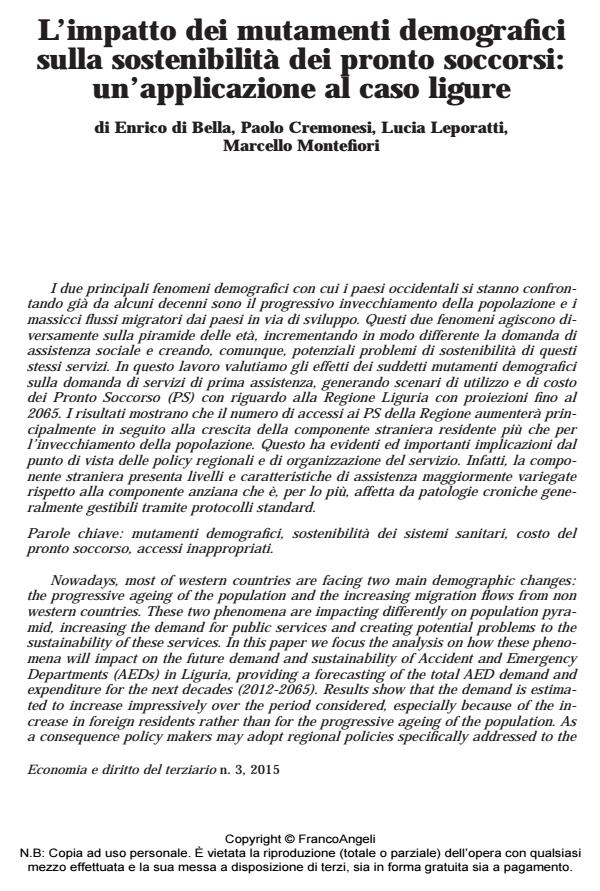L’impatto dei mutamenti demografici sulla sostenibilità dei pronto soccorsi: un’applicazione al caso ligure
Titolo Rivista ECONOMIA E DIRITTO DEL TERZIARIO
Autori/Curatori Enrico Di Bella, Paolo Cremonesi, Lucia Leporatti, Marcello Montelfiori
Anno di pubblicazione 2016 Fascicolo 2015/3
Lingua Italiano Numero pagine 21 P. 439-459 Dimensione file 464 KB
DOI 10.3280/ED2015-003004
Il DOI è il codice a barre della proprietà intellettuale: per saperne di più
clicca qui
Qui sotto puoi vedere in anteprima la prima pagina di questo articolo.
Se questo articolo ti interessa, lo puoi acquistare (e scaricare in formato pdf) seguendo le facili indicazioni per acquistare il download credit. Acquista Download Credits per scaricare questo Articolo in formato PDF

FrancoAngeli è membro della Publishers International Linking Association, Inc (PILA)associazione indipendente e non profit per facilitare (attraverso i servizi tecnologici implementati da CrossRef.org) l’accesso degli studiosi ai contenuti digitali nelle pubblicazioni professionali e scientifiche
L’etica sanitaria costituisce una componente imprescindibile delle attività svolte in seno al sistema di assistenza alla persona in stato di bisogno. Tradizionalmente, l’attenzione della letteratura scientifica e professionale è stata concentrata su un’interpretazione riduzionistica dell’etica sanitaria, che ha visto coincidere quest’ultima con il concetto di etica clinica. In termini diametralmente opposti, l’etica organizzativa è stata raramente oggetto di dibattito sia in ambito accademico che pratico. D’altro canto, le innovazioni istituzionali in una prospettiva di aziendalizzazione delle organizzazioni sanitarie, che - a livello internazionale - hanno interessato negli ultimi decenni i sistemi di assistenza dei Paesi occidentali, sono foriere di una crescente rilevanza dei determinanti organizzativi dell’etica sanitaria. In questa prospettiva, il presente studio si propone di fornire una sistematizzazione dei contributi della letteratura internazionale in tema di etica organizzativa in ambito sanitario, pervenendo all’individuazione di alcuni nodi critici ancora irrisolti. A tal fine, è stato adottato un approccio di review sistematica della letteratura, che ha interessato un totale di 206 articoli raccolti attraverso le banche dati "Scopus-Elsevier", "Web of Science" e "Pubmed". L’etica organizzativa si propone come elemento chiave in un’ottica di rinvigorimento della sostenibilità sociale e istituzionale delle organizzazioni sanitarie. Nondimeno, essa è tuttora largamente trascurata sia con riferimento alle dinamiche strategiche che alle attività di gestione delle aziende che operano al servizio del sistema sanitario.
Parole chiave:Etica organizzativa, organizzazioni sanitarie, etica clinica, comportamento organizzativo, sistema sanitario
Jel codes:D23, H75, I18
Enrico Di Bella, Paolo Cremonesi, Lucia Leporatti, Marcello Montelfiori, L’impatto dei mutamenti demografici sulla sostenibilità dei pronto soccorsi: un’applicazione al caso ligure in "ECONOMIA E DIRITTO DEL TERZIARIO " 3/2015, pp 439-459, DOI: 10.3280/ED2015-003004